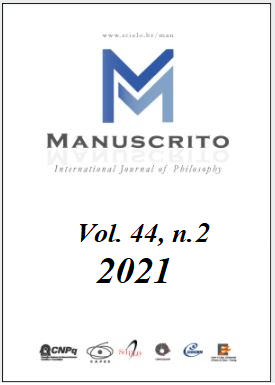Resumo
n this paper we present a concept of similarity in games, on which to ground alternative solution concepts, some of which differ from the classical notions in the field. In order to do this we impose a constraint on players’ beliefs that amounts to a variant of the well-known symmetry principle in classical bargaining theory. We show how this similarity relation helps to identify different Nash equilibria in games, and how these “similar Nash equilibria” can be extended to non-symmetric games. While the notion is normative, it is nonetheless inspired by phenomena in which similarities between players lead to outcomes detected in behavioral studies. We study the strategic properties of the concept of similarity and discuss its relationships with Hofstadter’ notion of superrationality.
Referências
AHMED, A. Evidence, Decision and Causality, Cambridge: Cambridge University Press, 2014.
AUMANN, R.‘Agreeing to disagree’, The Annals of Statistics, 4(6), 1236-1239, 1976.
AUMANN, R., BRANDENBURGER, A. ‘Epistemic conditions for Nash equilibrium’, Econometrica, 63(5), 1161-1180, 1995.
BACHARACH, M. ‘Interactive team reasoning: A contribution to the theory of co-operation’, Research in Economics, 53, 117-157, 1999.
BERNHEIM, D. ‘A Theory of Conformity’, Journal of Political Economy, 102(5), 841-877, 1994.
BICCHIERI, C., GREEN, S. ‘Symmetry arguments for cooperation in the prisoner’s dilemma’, in Holmström-Hintikka, Ghita, Tuomela, R. (Eds.), Contemporary Action Theory, Vol. II. (1997). Synthese Library, 229-249.
BONANNO, G. ‘Counterfactuals and the Prisoner’s Dilemma’, in Peterson, M. (Ed.), The Prisoner’s Dilemma (2015), Cambridge U. Press, 133-155.
BRANDENBURGER, A., FRIEDENBERG, A. ‘Intrinsic correlation in games’, Journal of Economic Theory, 141(1), 28-67, 2008.
BRANDENBURGER, A., KEISLER, H.J.‘An impossibility theorem on beliefs in games’, Studia Logica, 84(2), 211-240, 2006.
CAMPBELL, R. K. ‘The Prisoner’s Dilemma and the Symmetry Argument for Cooperation’, Analysis, 49(2), 60-65, 1989.
CAMERER, C. F., HO, T-H., CHONG, J-K. ‘A Cognitive Hierarchy Model of Games’, Quarterly Journal of Economics, 119(3), 861-98, 2004.
CPRARO, V., HALPERN, J. ‘Translucent players: Explaining cooperative behavior in social dilemmas’, Rationality and Society, 31(4), 371-408, 2019.
Chierchia, G, CORICELLI, G. ‘The impact of perceived similarity on tacit coordination: propensity for matching and aversion to decoupling choices’, Frontiers in Behavioral Neuroscience, 9, 202, 2015.
COLMAN, A. M., GOLD, N. ‘Team reasoning: Solving the puzzle of coordination’, Psychonomic Bulletin and Review, 25(5), 1770-1783, 2018.
CRAWFORD, V. ‘An “evolutionary” interpretation of Van Huyck, Battalio, and Beil’s experimental results on coordination’, Games and Economic behavior, 3(1), 25-59, 1990.
CRAWFORD, V., HALLER, H. ‘Learning how to cooperate: Optimal play in repeated coordination games’, Econometrica , 58, 571-595, 1990.
DALEY, B, SADOWSKY, P. ‘Magical Thinking: A Representation Result’, Theoretical Economics, 12, 909-956, 2017.
DAVIS, L. H. ‘Prisoners, paradox, and rationality’, American Philosophical Quarterly, 14(4), 319-327, 1977.
DI GUIDA, S., DEVETAG, G. ‘Feature-Based Choice and Similarity Perception in Normal-Form Games: An Experimental Study’, Games, 4(4), 776-794, 2013.
FEHR, E., SCHMIDT, K. ‘A Theory of Fairness, Competition, and Cooperation’, The Quarterly Journal of Economics , 114(3), 817-868, 1999.
FISCHER, I. ‘Friend or Foe: Subjective Expected Relative Similarity as a Determinant of Cooperation’, Journal of Experimental Psychology: General, 138(3), 341-350, 2009.
FLOOD, M, DRESHER, M. ‘Some experimental games’, Research memorandum RM-789. Santa Monica, CA: Rand, 1952.
FOURNY, G. ‘Perfect prediction in normal form: Superrational thinking extended to non-symmetric games’., Journal of Mathematical Psychology, 96, 102332, 2020.
FRANK, R. H., GILOVICH, T., REGAN, D. T. ‘The evolution of one-shot cooperation: An experiment’, Ethology and Sociobiology 14, 247-256, 1993.
FRANKFURT, H. ‘Alternate Possibilities and Moral Responsibility’, Journal of Philosophy, 66(23), 829-839, 1969.
GAUTHIER, D. Morals by Agreement, Oxford: Oxford University Press, 1986.
GILBOA, I., SSCHMEIDLER, D. A Theory of Case-Based Decisions, Cambridge: Cambridge University Press , 2001.
HARSANYI, J. C., SELTEN, R. A General. Theory of Equilibrium Selection inGames , Cambridge, MA: The MIT Press, 1988.
HOFSTADTER, D. R. ‘Dilemmas for superrational thinkers, leading up to a luring lottery’, Scientic American, 248(6), 1983.
HOFSTADTER, D. R. Metamagical themas: Questing for the essence of mind and pattern, New York: Basic Books, 1985.
JEHIEL, P. ‘Analogy-based expectation equilibrium’, Journal of Economic Theory 123, 81-104, 2005.
KANE, R. The significance of free will, Oxford: Oxford University Press , 1996.
LUCE, D., RAIFFA, H. Games and decisions: introduction and critical survey, New York: Wiley, 1957.
MUSSWEILER, T., OCKENFELS, A. ‘Similarity increases altruistic punishment in humans’, Proceedings of the National Academy of Sciences, 110(48), 19318-19323, 2013.
MYERSON, R. B. Game Theory: Analysis of Conflict, Boston, MA: Harvard University Press, 1991.
NASH, J. F. ‘The Bargaining Problem’, Econometrica , 18(2), 155-62, 1950.
RAPOPORT, A. Fights, games, and debates, Ann Arbor: University of Michigan, 1960.
REICHENBACH, H. The Direction of time, Berkeley: University of Los Angeles Press, 1956.
ROSS, D. Philosophy of Economics, New York: Palgrave Macmillan, 2014.
RUBINSTEIN, A., SALANT, Y. ‘"Isn’t everyone like me?": On the presence of self-similarity in strategic interactions’, Judgment and Decision Making, 11(2), 168-173, 2016.
SHACKEL, ‘Bertrand’s Paradox and the Principle of Indifference’. Philosophy of Science, 74(2), 150-175, 2007.
SHAFIR, E., TVERSKY, A. ‘Thinking Through Uncertainty: Nonconsequential Reasoning and Choice’, Cognitive Psychology, 24(4), 449-474, 1992.
SINN, H. W. ‘A rehabilitation of the principle of insufficient reason’, Quarterly Journal of Economics , 94(3), 493-504, 1980.
SPIEKERMANN, K. ‘Translucency, assortation, and information pooling: how groups solve social dilemmas’, Politics, Philosophy and Economics, 6, 285-306, 2007.
TOHMÉ, F., CATERINA, G., GANGLE, R. ‘Local and global optima in decision-making: a sheaf-theoretical analysis of the difference between classical and behavioral approache’, International Journal of General Systems, 46(8), 879-897, 2017.
TOHMÉ, F., VIGLIZZO, I.‘Superrational types’, Logic Journal of the IGPL, 27(6), 847-864, 2019.
VAN HUYCK, J. B., BATTALIO, R., BEIL, R. ‘Tacit CoordinationGames , Strategic Uncertainty, and Coordination Failure’, American Economic Review, 80(1), 234-48, 1990.

Este trabalho está licenciado sob uma licença Creative Commons Attribution 4.0 International License.
Copyright (c) 2021 Carlos Maximiliano Senci, Fernando Abel Tohmé


